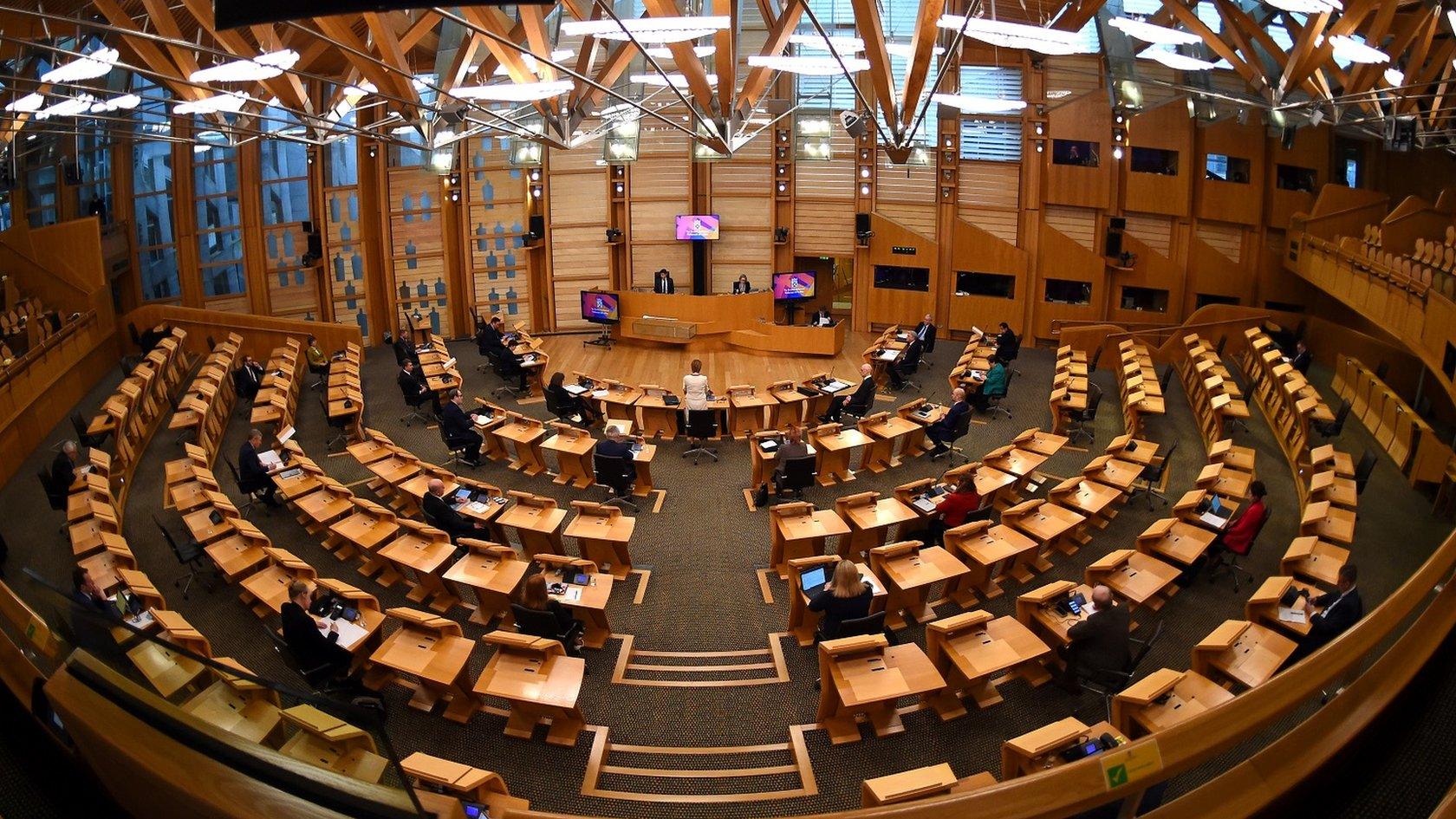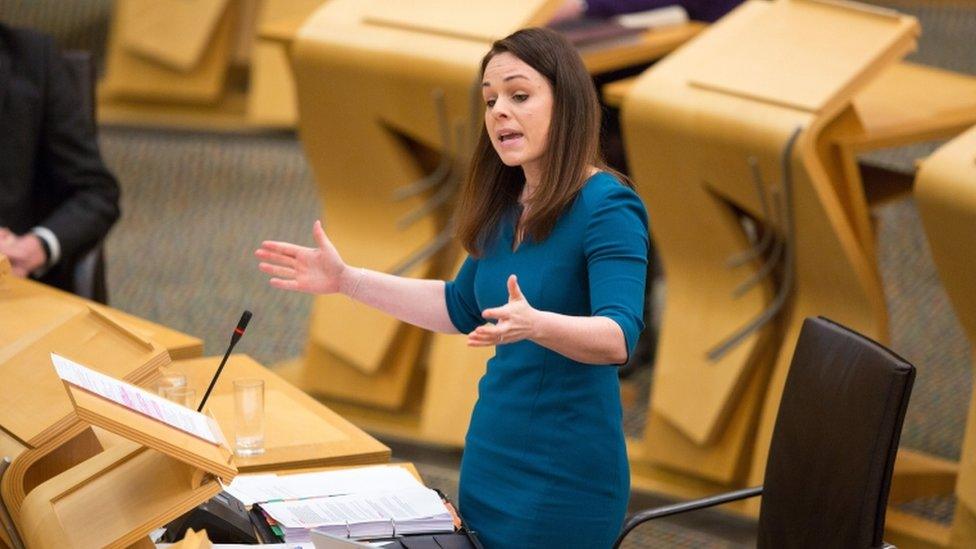Scottish income tax 2021-22 - What might you be paying?
- Published

The Scottish government's draft budget includes no changes to income tax rates and bands in the coming financial year.
But what Finance Secretary Kate Forbes has proposed is only part of the picture for tax payers north of the border. That is because the 2021-22 Budget presented to Holyrood comes ahead of UK Chancellor, Rishi Sunak's Budget statement on 3 March
So, based on a part picture - one which does not include definite changes to the personal allowance - tax consultant Deloitte has put together examples spanning different salaries.
The lower earner
£15,000 salary
If you earn a salary of £15,000 in 2021-22 and have no other income, the personal allowance of £12,570 (assuming this is increased in line with the Consumer Prices Index, as planned) will be deducted and £2,430 will be taxable.
If you are resident in Scotland, your income tax calculation will be as follows;
Scottish starter rate - £2,097 at 19%= £398.43
Scottish basic rate - £333 at 20% = £66.60
Total tax = £ 465.03
This is a decrease of £14.12 compared to 2020-21 due to the expected increase in the personal allowance from £12,500 to £12,570 and the small increase in the starter band from £2,085 to £2,097.
If you earned the same sum of money but were not resident in Scotland the full £2,430 would be taxable at 20% (UK basic rate) producing an income tax bill of £486. Therefore, you would pay £20.97 less as a resident of Scotland.
The medium to higher earners
£33,000 salary
If you earn a salary of £33,000 in 2021-22 and have no other income, the personal allowance of £12,570 will be deducted and £20,430 will be taxable. If you are resident in Scotland, your income tax will be as follows:
Scottish starter rate - £2,097 at 19% = £398.43
Scottish basic rate - £10,629 at 20% = £ 2,125.80
Scottish intermediate rate - £7,704at 21% = £1,617.84
Tax total = £ 4,142.07
This is a decrease of £15.50 compared to 2020-21 due to the increase in the personal allowance and the small inflationary increases in the starter, basic and intermediate rate bands.
If you were resident elsewhere in the UK, the full £20,430 would be taxable at 20%, giving an income tax liability of £4,086. A Scottish resident would pay an additional £56.07 in income tax compared with living elsewhere in the UK.
£50,000 salary
If you earn a salary of £50,000 in 2021-22 and have no other income, £37,430 will be taxable after deduction of the £12,570 personal allowance.
If you are resident in Scotland, the tax calculation will be as follows;
Scottish starter rate - £2,097 at 19% = £398.43
Scottish basic rate - £10,629 at 20% = £ 2,125.80
Scottish intermediate rate - £18,366 at 21% =£3,856.86
Scottish higher rate - £6,338 at 41%= £2,598.58
Total tax = £ 8,979.67
This is a decrease of £61.90 compared to 2020-21 due to the increase in the personal allowance and the small inflationary increases in the starter, basic and intermediate rate bands.
If you were not resident in Scotland, the full £37,430 will be taxable at 20% (UK basic rate) producing an income tax bill of £7,486. You would therefore be paying £1,493.67 more in tax as a resident of Scotland.
The higher earner
£200,000 salary
If you earn a salary of £200,000 in 2021-22 and have no other income, you are not entitled to a personal allowance because your income exceeds £125,140. The taxable income is therefore £200,000.
If you are a resident in Scotland, your income tax breaks down is as follows:
Scottish starter rate - £2,097 at 19% = £398.43
Scottish basic rate - £10,629 at 20% = £ 2,125.80
Scottish intermediate rate - £18,366 at 21% =£3,856.86
Scottish higher rate - £118,908 at 41% = £ 48,752.28
Scottish additional rate - £50,000 at 46% = £23,000
Total tax = £78,133.37
This is a decrease of £33.20 compared to 2020-21 due to small increases in the starter, basic rate and intermediate rate bands.
If you are a resident elsewhere in the UK, on this salary you would pay £74,960 in tax (assuming the UK basic rate band is increased in line with the Consumer Prices Index to £37,700 as planned) - £3,173.37 less than north of the border.
Analysis - 'Uncertainty' until UK Budget on 3 March
Douglas Farish, Tax Partner at Deloitte, said: "For the second year in a row the Scottish government has been required to set out its plans for the year ahead without knowing the full tax and spending breakdown from the UK government. If the UK government were to make any significant changes to income tax for the rest of the UK, the Scottish government may need to revisit its figures.
"As expected, the Scottish government announced there will be no change to income tax rates, with starter, basic and intermediate bands increasing at the same rate as inflation. This is the first time that the Scottish higher rate threshold has increased since 2018-19, although it still lags behind the UK higher rate threshold, which is expected to be £50,270.
"Based on the changes announced today, there are modest tax savings for all Scottish taxpayers, as the starter, basic rate and intermediate bands have increased by CPI inflation giving a Higher rate threshold of £43,662 (previously £43,430) while the Scottish top rate threshold remains at £150,000.
"It should be noted that the bulk of the savings for most taxpayers will be due to the increase in the personal allowance. The maximum effect of the rate band increases is £33.20. However, the overall position does depend on any changes to the personal allowance and tax rates and bands made in the UK budget on 3 March.
"Lower earners continue to pay less tax than those in the rest of the UK; in 2020-21 the breakeven earnings were £27,243. The equivalent for 2021-22 is £27,393.
"Those earning £50,000 or less will see a small saving in National Insurance due to the increase in the primary threshold from £9,500 to £9,568 annually (with equivalent figures for those paid weekly or monthly). This will give an NIC saving of up to £8.16 pa for employees and £6.12 pa for the self-employed; those earning over £9,568 will see the full savings. Higher earners will pay slightly more NIC (up to £18.84 extra) due to the increase in the upper threshold to £50,270.
"This also means there will be no further income tax divergence between Scotland and the rest of the UK. However, this is based on the assumption that UK personal allowance and Higher rate tax will be increased in line with the Consumer Prices Index, as set out in the 2020 Spending Review, so there remains an element of uncertainty for Scottish taxpayers until the UK government gives its full fiscal statement on 3 March."
Related topics
- Published28 January 2021

- Published28 January 2021
